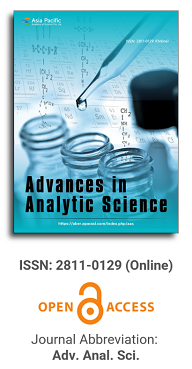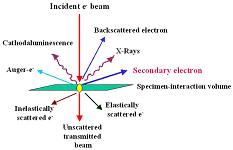
Asia Pacific Academy of Science Pte. Ltd. (APACSCI) specializes in international journal publishing. APACSCI adopts the open access publishing model and provides an important communication bridge for academic groups whose interest fields include engineering, technology, medicine, computer, mathematics, agriculture and forestry, and environment.

Chromatographic analysis techniques are essential for effective sample testing and quantification. This issue explores liquid and gas chromatography, enabling researchers to identify harmful substances and active components.
Issue release: 31 December 2023
The use of bisphenol-A (BPA) in global industry has been increasing in recent years, with emerging markets driving this growing demand. BPA applications in the food and beverage industry account for only 3% to 4% of global polycarbonate consumption, but its use is being re-examined as several scientific papers have come to light indicating a direct link between BPA and adverse health effects. Contamination of food and beverages occurs by migration of BPA from the containers that contain it (canned foods, wines, etc.), and is the main source of human exposure. To evaluate such exposure, an analytical method by gas chromatography coupled to mass spectrometry was developed and validated for the quantification of total BPA in urine of pregnant women attended at the Italian Hospital of Buenos Aires in 2013, with a limit of quantification of 2.0 ng/mL and a limit of detection of 0.8 ng/mL. Of the 149 urine samples analyzed, 66.4% were quantifiable, with the median total BPA of 4.8 ng/mL (4.3 ng/mg creatinine) and the geometric mean of 4.8 ng/mL (4.7 ng/mg creatinine).
Issue release: 31 December 2023
Effective control of food quality and safety requires analytical methods that guarantee the reliable determination of any substance potentially harmful to the consumer that may be present in the food prior to its distribution and marketing. One of the analytical approaches that contributes to guarantee this objective encompasses a series of techniques that have in common the use of antibodies as essential elements for the detection of the target analyte, and which together are called immunochemical methods. This article aims to provide a basic overview of the biochemical principles underlying these technologies and their advantages and limitations in the determination of chemical contaminants, residues and additives in food matrices. The last part discusses some of our initiatives in this field that have resulted in commercially available rapid kits after transferring the corresponding technology to the industrial sector.
Issue release: 31 December 2023
The evaluation of contaminants present in the environment is a recurring theme at the international level, which is why it is imperative to develop new methodologies for the extraction of analytes from matrices such as surface water, with a low impact on the environment. Chlorpyrifos (CP) is an organophosphate compound widely used for pest control, toxic to living organisms, which can be mobilized from soils to different water sources. Dispersive liquid-liquid microextraction (DLLME) can be considered as a methodology with green analytical chemistry characteristics, due to its low solvent and time consumption. The objective of this work was to optimize DLLME for the analysis of CP in water samples. For the extraction, methanol was used as dispersing agent and CS2 as extracting agent, and five extraction times were evaluated: 5, 10, 15, 15, 20 and 25 min. The extracts were analyzed by gas chromatography with electron microcapture detector (GC-μECD). The results of the shaking time evaluation showed that, for the shaking times of 10 and 15 min, a CP recovery percentage of 108% and 88% was obtained, respectively, with a detection and quantification limit of 18.3 and 22.4 μg/L, respectively, and a precision expressed as relative standard deviation of less than 14.2%, which is acceptable for this type of extraction. It can be concluded that the DLLME methodology associated with GC-μECD is a suitable alternative for the quantification of CP in aqueous matrices with a low environmental impact.
Issue release: 31 December 2023
To mensurate the content of vitamin A (vitamin A1, vitamin A2) in fish liver accurately, methods of sample pretreatment (including water bath saponification, room temperature saponification, and direct extraction) and detection methods (including normal phase chromatography and reversed phase chromatography) were screened and applied to the mensuration of vitamin A in the liver of 9 economic fish species. The results revealed that by reversed phase chromatography vitamin A1 and vitamin A2 were effectively divided, and showed good linear relationship within their respective linear ranges (R2 > 0.99).The content of vitamin A extracted by water bath saponification was distinctly higher than the contentof Vitamin A by room temperature saponification and direct extraction (p < 0.05). Its average recovery rates of vitamin A1 and vitamin A2 were respectively 104.52% and 90.94%. The total content of vitamin A in the livers of other freshwater fishes and marine fishes except for the freshwater snakehead and big mouth bass was more than 200 μg/100 g, and the total content of vitamin A in the liver of marine giant grouper is 14,413.78 μg/100 g, among the result was the highest. The water bath saponification method with reversed phase chromatography has good precision and is suitable for the mensuration of vitamin A in fish liver.
Issue release: 31 December 2023
Objective: To develop and compare methods for quantifying residual free formaldehyde in vaccines using pre-column and post-column derivatization liquid chromatography, and to assess the consistency between these methods. Methods: For pre-column derivatization, we used a Shimadzu LC-20AT liquid chromatograph equipped with an SPD-20A UV detector. Separation was achieved with a mobile phase consisting of 60% acetonitrile at a flow rate of 0. 8 mL·min−1 and a column temperature of 40 ℃. Detection was performed at 360 nm using a Kromasil 100-5-C18 (250 mm × 4.6 mm) column. For post-column derivatization, we employed a Shimadzu LC-20AT liquid chromatograph with an SPD-M20A diode array detector and a vector derivative device. Separation was conducted with a mobile phase of 0.2% (V/V) phosphoric acid at a flow rate of 1.0 mL·min−1 and a column temperature of 25 ℃. Detection was carried out at 412 nm using a Chrom Core AQ-C18 (250 mm × 4.6 mm) column. The derivatization solution was acetate buffer, flowing at 0.5 mL·min−1 and maintained at 100 ℃. Both methods were evaluated for precision, repeatability, and sample recovery, with statistical significance assessed using F-test and t-test. Results: The pre-column derivatization method exhibited linearity over the range of 0.025–100 μg·mL−1 (R = 0.9999, n = 12). Precision showed an RSD value of 0.06%, and repeatability ranged from 0.3% to 1.4%. Average recoveries were between 97.3% and 104.8%, with RSD values from 0.7% to 2.9%. The limit of quantitation (LOQ) was 0.02 μg·mL−1, and the limit of detection (LOD) was 0.01 μg·mL−1. The post-column derivatization method demonstrated linearity in the same range (0.025–100 μg·mL−1, R = 0.9999, n = 12). Precision showed an RSD value of 0.02%, and repeatability ranged from 0.7% to 3.5%. Average recoveries were between 105.6% and 114.6%, with RSD values from 0.3% to 1.9%. The LOQ was 0.02 μg·mL−1, and the LOD was 0.006 μg·mL−1. Statistical analysis indicated that both methods produced comparable results. Conclusion: Both pre-column and post-column derivatization liquid chromatography methods are simple, accurate, and highly sensitive, making them suitable for determining residual free formaldehyde in vaccines.
Issue release: 31 December 2023
A rapid and straightforward method has been devised for direct analysis of SiO2, Al2O3, Fe, MgO, CaO, K2O, Mn, TiO2, P, and Zn in manganese ore samples using an X-ray fluorescence spectrometer (XRF). The method employs a glass fusion technique with a flux composed of Li2B4O7, LiBO2, and LiF (in a mass ratio of 45:10:5), NH4NO3 as an oxidizing agent, and LiBr as a stripping agent. The method's experimental parameters were fine-tuned, and its performance metrics were assessed. The proposed method was used to analyze the certified reference materials GBW07261 to GBW07266, yielding relative standard deviations (RSD, n = 12) below 2%. Accuracy was verified using synthetic samples, and the obtained results were in line with the certified values.
1.jpg)
Prof. Sivanesan Subramanian
Anna University, India


 Open Access
Open Access



.jpg)
